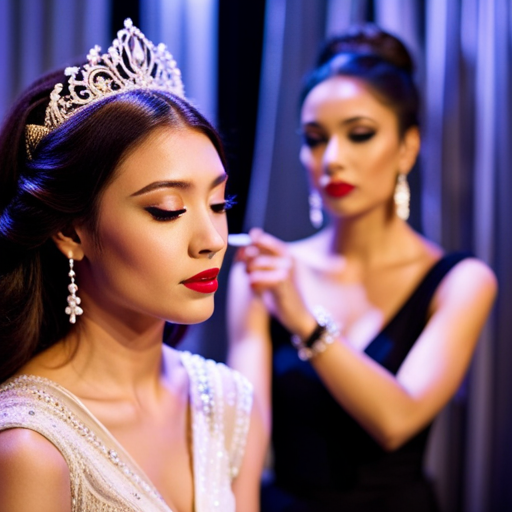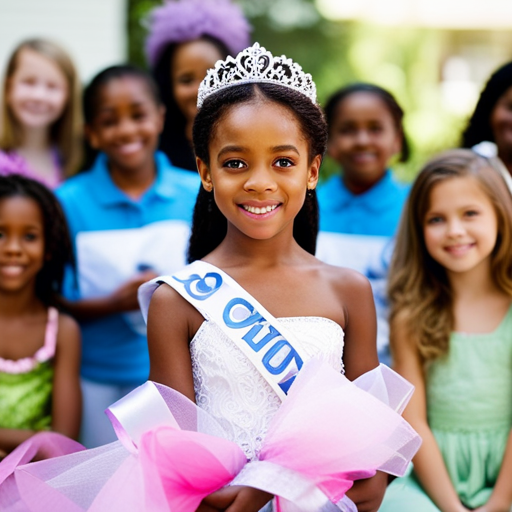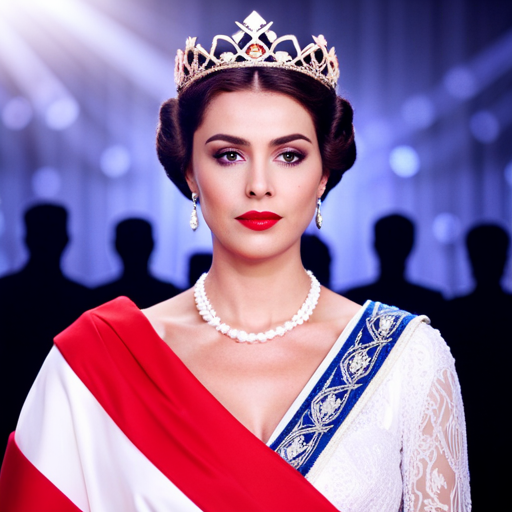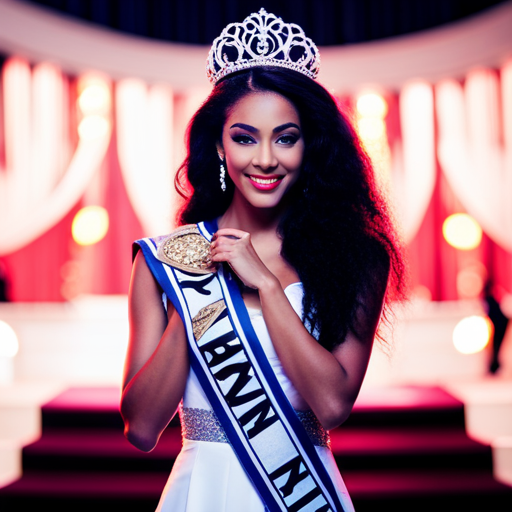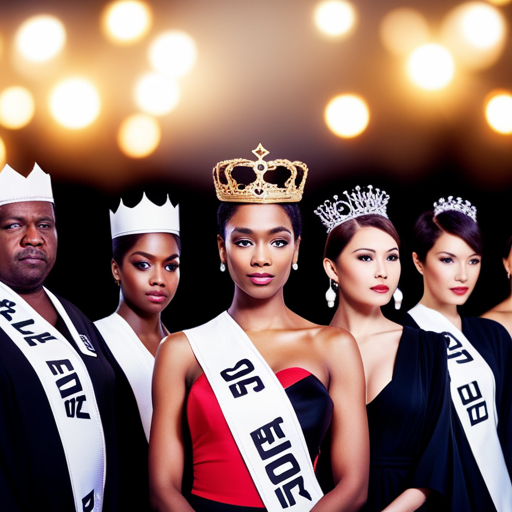The Role of Pageants in Cultural Representation
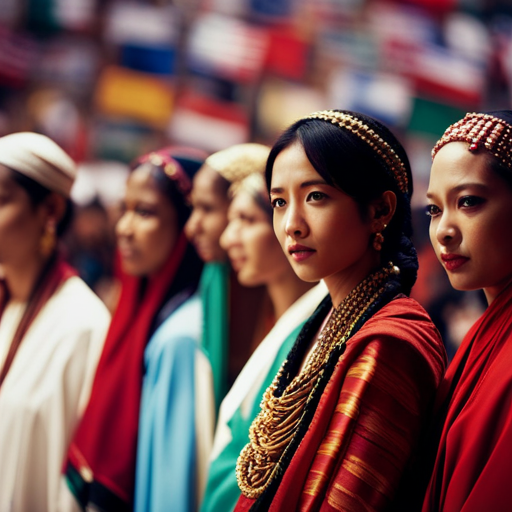
Did you know that over 3,000 beauty pageants are held annually around the world?
Beyond showcasing physical beauty, these events play a significant role in representing and celebrating cultural diversity.
This article explores the historical significance of pageants, their impact on challenging stereotypes, and their role in shaping beauty perceptions.
Additionally, it examines how pageants serve as platforms for cultural exchange and empowerment.
Join us in exploring the multifaceted role of pageants in cultural representation.
Historical Significance of Pageants
Examining the historical significance of pageants reveals their evolution as a platform for cultural representation and celebration. Throughout history, pageants have served as a reflection of societal values and norms, providing a lens through which to understand cultural celebrations and the representation of diverse communities. These events have showcased traditional attire, customs, and rituals, offering a glimpse into the rich tapestry of global cultures. Pageants have often mirrored the societal ideals of beauty, grace, and talent, influencing and reflecting the prevailing standards of each era. Moreover, they have played a pivotal role in promoting cultural understanding and appreciation, fostering unity and respect among different communities.
The historical evolution of pageants underscores their deep-rooted connection to cultural celebration and societal reflection. As these events have transformed over time, they have continued to serve as a platform for the representation and celebration of diverse cultures. This evolution has been instrumental in shaping the contemporary landscape of pageantry, paving the way for the meaningful representation of cultural diversity on a global scale.
Representation of Cultural Diversity
The representation of cultural diversity in pageants showcases a rich tapestry of global traditions and customs, fostering unity and appreciation among diverse communities. Pageants serve as platforms for cultural celebration, allowing contestants to proudly display their heritage while promoting cross-cultural understanding.
These events offer a unique opportunity to highlight the beauty and significance of various cultural practices, attire, music, dance, and rituals. By featuring contestants from different ethnic backgrounds, pageants contribute to a more inclusive representation in media, challenging stereotypes and promoting cultural exchange.
Moreover, the visibility of diverse cultural representations in pageants helps combat cultural appropriation and misrepresentation in mainstream media. It provides a space for authentic narratives to be shared, fostering mutual respect and understanding.
Ultimately, the representation of cultural diversity in pageants serves as a powerful tool for promoting global cultural appreciation, breaking down barriers, and building connections across communities. As such, pageants play a crucial role in shaping a more inclusive and culturally diverse media landscape.
Challenging Stereotypes Through Pageants
With a focus on challenging stereotypes, pageants provide a platform for contestants to actively counter misconceptions and promote a more accurate understanding of diverse cultures and traditions. Through their participation, contestants challenge stereotypes, empowering themselves and others, while shaping their own identities and the perceptions of those watching.
Here are five ways in which pageants help in challenging stereotypes:
-
Promoting Cultural Understanding: Contestants showcase their cultural heritage, educating audiences and challenging preconceived notions.
-
Breaking Beauty Standards: Contestants of various shapes, sizes, and backgrounds redefine traditional beauty norms, promoting inclusivity and diversity.
-
Empowering Women: Pageants often provide opportunities for women to speak out on social issues, challenging gender stereotypes and advocating for change.
-
Celebrating Diversity: By showcasing a wide array of talents, traditions, and customs, pageants celebrate the richness of diverse cultures, challenging monolithic representations.
-
Inspiring Confidence: Contestants serve as role models and inspire others to embrace their unique identities, challenging societal pressures to conform.
The impact of these efforts extends beyond the pageant stage, influencing beauty perceptions and cultural attitudes in society at large.
Impact on Shaping Beauty Perceptions
An analysis of pageants’ influence reveals their significant impact on shaping beauty perceptions in contemporary society. Pageants, through media influence and societal impact, play a crucial role in defining and perpetuating beauty standards. These events often showcase a narrow definition of beauty, emphasizing physical appearance over other qualities. Such portrayal can lead to psychological effects on individuals, impacting their self-esteem and self-worth. The pressure to conform to these standards can be detrimental, especially to young and impressionable individuals who may internalize these ideals.
| Beauty Perceptions | Impact |
|---|---|
| Narrow definitions of beauty | Can lead to low self-esteem |
| Emphasis on physical appearance | Psychological effects on individuals |
| Unrealistic standards | Pressure to conform |
| Lack of diversity | Negative impact on self-worth |
| Influence on societal beauty ideals | Media perpetuation of beauty standards |
These beauty perceptions perpetuated by pageants can contribute to a culture of comparison and unrealistic expectations, highlighting the importance of promoting diverse representations of beauty. Efforts to broaden the definition of beauty and emphasize inner qualities should be encouraged to mitigate the negative impact of pageants on shaping beauty perceptions.
Empowerment and Identity in Pageants
Empowerment and identity formation are integral aspects of pageants’ cultural significance. Pageants serve as platforms for individuals to embrace their identity and celebrate their cultural heritage. Here are five key points that highlight the significance of empowerment and identity in pageants:
-
Self-Confidence: Pageants provide participants with opportunities to build self-confidence and self-esteem, empowering them to embrace their unique identities.
-
Cultural Representation: Through traditional attire, performances, and presentations, pageants offer a platform for individuals to express and celebrate their cultural heritage, contributing to the rich tapestry of diversity.
-
Personal Growth: Engaging in pageants can lead to personal growth and a deeper understanding of one’s cultural identity, fostering a sense of empowerment and belonging.
-
Empowerment of Women: Pageants often focus on empowering women, providing a platform for them to voice their opinions, showcase their talents, and advocate for causes important to them.
-
Community Connection: Pageants can bring communities together, fostering a sense of unity and pride in cultural representation.
These aspects underscore the profound impact of pageants on the empowerment and identity formation of participants, making them invaluable cultural celebrations.
Transitioning into the subsequent section, these pageants also serve as platforms for cultural exchange, facilitating dialogue and understanding among diverse communities.
Pageants as Platforms for Cultural Exchange
Pageants serve as powerful platforms for promoting cultural diversity, global awareness, and understanding. They provide a space where individuals from different cultural backgrounds can come together to celebrate their heritage and traditions, fostering mutual respect and appreciation.
Through pageants, contestants and audiences alike are exposed to a wide array of cultural experiences, ultimately contributing to the exchange of ideas and the promotion of cross-cultural understanding.
Promoting Cultural Diversity
In the contemporary global landscape, pageants have emerged as significant platforms for promoting cultural diversity through the exchange of traditions and values. These events play a crucial role in fostering cultural celebration and diversity promotion. They showcase traditional attire, dances, and rituals from various cultures. Pageants also provide a platform for contestants to share their cultural heritage and promote understanding. Additionally, they encourage intercultural dialogue and appreciation of different customs and practices. Pageants offer opportunities for individuals from diverse backgrounds to come together and form meaningful connections. They also play a role in elevating underrepresented cultures and amplifying their voices on a global stage. Through these initiatives, pageants actively contribute to the promotion of cultural diversity and understanding, fostering a more inclusive and interconnected global community.
Global Awareness and Understanding
Pageants serve as international platforms for cultural exchange and global awareness, facilitating the sharing of diverse traditions and fostering cross-cultural understanding. Through these events, participants from various countries showcase their unique cultural heritage, traditions, and values, providing a rich tapestry of global diversity. This exchange of cultural knowledge and experiences not only promotes mutual respect and appreciation but also helps in breaking down stereotypes and fostering a global perspective. It allows individuals from different parts of the world to come together, learn from each other, and celebrate their differences. This global awareness and understanding cultivated through pageants contribute to the promotion of tolerance, empathy, and interconnectedness on a worldwide scale.
| Benefits of Pageants as Platforms for Cultural Exchange | ||
|---|---|---|
| Promotes mutual respect | Fosters global perspective | Breaks down stereotypes |
| Celebrates global diversity | Encourages cross-cultural understanding | Cultivates empathy |
Criticisms and Future of Pageants
As pageants continue to evolve, criticisms have arisen regarding the perpetuation of traditional beauty standards and the need for more inclusive judging criteria. These criticisms prompt a reevaluation of the future of pageants and the role they play in cultural representation.
It is essential to consider how pageants can adapt to reflect the diverse beauty standards and values of society in order to remain relevant and meaningful in the future.
Evolving Beauty Standards
The evolving beauty standards in the pageant industry have sparked criticisms and raised questions about the future of these events. As changing ideals and societal norms continue to shape our perceptions of beauty, pageants face scrutiny regarding their role in perpetuating narrow beauty standards.
Some key considerations include:
- Representation of diverse body types and ethnicities.
- Impact on the mental health of participants.
- Relevance in the modern era of gender equality and empowerment.
- Responsibility in promoting healthy body image.
- Incorporation of talent and intellect over physical appearance.
These criticisms prompt a reevaluation of the purpose and relevance of pageants in today’s society. As the industry evolves, the future of pageants hinges on their ability to adapt to progressive beauty standards and address the concerns raised by their critics.
Inclusive Judging Criteria
Amidst the evolving beauty standards within the pageant industry, it is imperative to scrutinize the inclusive judging criteria as a determinant of the future direction of these events.
Inclusive judging criteria play a pivotal role in shaping the cultural celebration aspect of pageants. However, criticisms have emerged regarding the limited representation of diverse cultural backgrounds and body types in the judging criteria.
To ensure the future relevance and resonance of pageants, there is a pressing need to address these criticisms and adapt the judging criteria to be more inclusive. This entails embracing a broader definition of beauty that encapsulates the diversity of cultures and body types.
Moving forward, the future of pageants hinges on their ability to celebrate and represent a wide spectrum of cultural identities through their judging criteria.
Frequently Asked Questions
How Have Pageants Evolved Over Time to Incorporate a More Diverse Range of Cultural Representations?
Pageants have evolved to encompass a more diverse range of cultural representations by embracing various ethnicities, traditions, and values. This evolution has empowered individuals to challenge stereotypes and promote inclusivity and representation on a global stage.
What Specific Measures Are Pageants Taking to Challenge and Break Down Stereotypes of Beauty and Culture?
Pageants are embracing diversity and inclusivity by implementing judging criteria that measure progress in challenging beauty and cultural stereotypes. Through initiatives like diverse contestant selections and promoting cultural awareness, they are breaking barriers in representation.
How Do Pageants Contribute to Shaping the Beauty Perceptions of Individuals From Different Cultural Backgrounds?
Pageants play a pivotal role in shaping beauty perceptions across cultures, influencing shifting standards and trends. Their global impact is undeniable, as they showcase diverse representations of beauty, fostering cross-cultural understanding and appreciation.
What Opportunities Do Pageants Offer for Individuals to Express and Explore Their Cultural Identity and Empowerment?
Pageants offer a platform for individuals to express cultural identity, challenge stereotypes, and promote empowerment. They provide opportunities for diverse representation, industry reforms, and inclusivity, fostering a space for exploring and celebrating cultural diversity.
What Are Some Potential Changes or Reforms That Could Help Address the Criticisms Surrounding Pageants and Ensure a More Inclusive and Positive Future for the Industry?
Potential reforms for pageants to address criticisms and ensure inclusivity and empowerment include diversifying judging panels, promoting cultural representation, and implementing strict guidelines on respectful portrayal of diverse cultures. These changes can lead to a more positive future for the industry.
Conclusion
In conclusion, pageants serve as a vibrant tapestry of cultural representation, weaving together the threads of diversity, empowerment, and challenge to stereotypes.
Like a kaleidoscope, they reflect the varied hues of beauty and identity, creating a mosaic of shared experiences and values.
Despite criticism, pageants continue to be a stage for cultural exchange, shaping perceptions and celebrating the rich tapestry of human expression.
As the world turns, pageants will continue to evolve, reflecting the ever-changing landscape of cultural representation.
